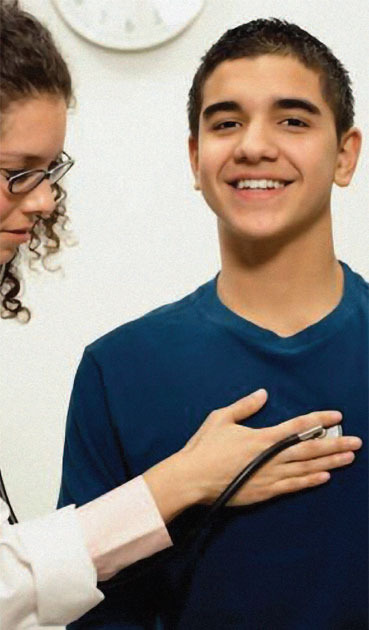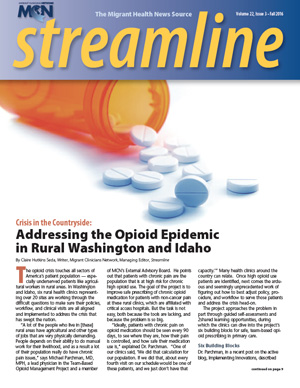The Social Determinants of Adolescent Health: Q&A with Dr. Tamara Baer

[Editor’s Note: In this piece, John Schlitt, President of the School-Based Health Alliance (SBHA), interviews Dr. Tamara Baer about arecent article on adolescent health. Read the full article at SBHA’swebsite, www.sbh4all.org. Submit abstracts for SBHA’s 2017National School-Based Health Care Convention at https://goo.gl/wyfhfs.]
Sometimes the contents of the doctor’s medicine bag are just plain insufficient. Innovators in medicine and public health are re-imaging traditional adolescent care management tools to help providers and systems tackle the significant—and often devastating—effects of social, economic, and environmental conditions on the health and wellbeing of young people. Some call it upstream medicine: treating the root cause rather than the symptom.
Three national physician leaders, Tamara Baer, Laura Gottlieb, and Megan Sandel, in an article published in Current Opinion in Pediatrics, made a strong case for an upstream framework to address the influences of poverty and social disadvantage on adolescent health outcomes.1 The physicians prescribe a model for practice transformation that identifies and remediates non-medical threats to adolescent health. To better equip the adolescent medical home, the authors outline three fundamental strategies:
- Improve triage for social determinants of health need.
- Develop a comprehensive community resource referral system.
- Expand the team to include a community resource connector. School-Based Health Alliance President, John Schlitt, spoke with lead author, Dr. Tamara Baer, about the role of social determinants in adolescent health and how providers can make practice adaptations to respond more effectively to them.
John: You make a compelling case for aligning a public health construct with traditional medical practice. And it seems particularly tailor made for adolescents.
Dr. Baer: Adolescents are especially vulnerable to risks commonly associated with their developmental stage. Add to those risks the context of their social environment, which has a weighty effect on their behaviors – injuries and violence, substance use, sexual activity. If there is nothing to counterbalance the influence of social determinants of health (SDOH) like poverty and unremitting stress, or inadequate access to basic needs like food and shelter, these behaviors can have a cumulative effect with serious life-long health consequences. Research has shown that adolescents with greater social needs are at higher risk for poor health outcomes.
John: Your recommendation to include social determinants in screening tools seems rather practical.
Dr. Baer: You can’t intervene if you don’t ask the questions. We urge providers to take a critical look at screening tools for adolescent patients: are they inclusive of items like personal safety, food security, income instability, home life, school performance? What about frequency of screening: are you asking about basic social needs at every visit? Unfortunately, for too many teens, any of these factors can change from month to month.
John: Have you encountered any specific standardized tools that align with your framework?
Dr. Baer: There are several that we found in our research. A great example comes from the National Center for Medical-Legal Partnership, which developed a social screening assessment that includes income, housing, education, legal status, literacy and personal safety – the mnemonic IHELLP. In addition, The University of Michigan has developed a screening tool called Rapid Assessment for Adolescent Preventive Services – Public Health (RAAPS-PH) intended for youth impacted by conditions of poverty and addresses areas such as hunger and housing.
John: Is there any one factor that seems to be correlated with co-occurring risk?
Dr. Baer: Food insecurity alone can be a valuable way to identify hunger as well as risk for other social problems. The American Academy of Pediatrics (AAP) now recommends that health care providers routinely screen children and adolescents for food insecurity using two validated questions that were adapted from the U.S. Department of Agriculture (USDA) Household Food Security Scale, and validated by Erin Hager and colleagues: 1) “Within the past 12 months, we worried whether our food would run out before we got money to buy more,” and 2) “Within the past 12 months, the food we bought just didn’t last and we didn’t have money to get more.” Research that I recently published demonstrated that youth who answered yes to one or both of those questions have significantly greater likelihood of also experiencing other social problems, including health care access, housing, education, income insecurity and substance use.
John: How do you push back against the argument that providers are too constrained for time to address adolescent SDOH issues?
Dr. Baer: In addition to researching the benefits of short screening tools like the 2-item food insecurity screen, we’ve discovered some online tools that health care practices and clinics could adopt to facilitate self-screening by the patient. It doesn’t take time out of the clinical interaction. My colleagues at Boston’s Children created a web-based platform called HelpSteps that includes a self-administered needs assessment, which, upon completion, triggers targeted referrals to community-based resources. It’s been tested to be highly effective with adolescents in clinical settings in Massachusetts. There is another distinct advantage to web-based electronic screening instruments besides being cost and resource efficient – they may be more effective at eliciting highly sensitive information for adolescents.
John: Where do clinics and offices start in developing a comprehensive community resource referral system?
Dr. Baer: It’s overwhelming and reasonable for a provider to think, “How am I to respond to my patients’ complex social issues?” if they believe they’re in it alone. But they have many potential partners who share in their goal of patients’ health and safety. Community resource guides are quite common and available through local public and private child and family service agencies. A great model being used in a number of cities is CAP4Kids, a website that links healthcare providers, social workers, child advocates and parents and teens with up to date information on community resources.
John: I imagine most health practices aren’t configured for this. How do you convince providers to take on additional staff?
Dr. Baer: Every health care home needs a resource connector of sorts – but it doesn’t necessarily require advanced degrees or highly-priced expertise. Some of the most creative innovations, in fact, are being led by models using volunteers and paraprofessionals. One of the best known examples is Health Leads, which employs college student volunteers who are trained to assist families in filling social prescriptions that meet basic needs. Community and street outreach workers are integrated into health care teams to engage in patient advocacy around housing, job training, education and health care. John: Are these practice reforms sustainable?
Dr. Baer: Yes, absolutely. Just this month Centers for Medicaid and Medicare Services (CMS) announced a first-ever innovation model to address SDOH. Health care payment reforms are definitely moving in this direction. Accountable care organization and patient-centered medical home models are looking to reward providers to pay more attention to social determinants, to get to the root cause of disease. When outcomes rather than units of service become valued by health payers, we’re going to see much more innovation in care coordination.
John: Is there anything else you consider imperative for providers to consider when addressing the wellbeing of young people?
Dr. Baer: All youth should be screened for social determinants, because these are often ‘hidden’ problems that health care providers may not detect and youth will not bring up without asking. However, certain groups of youth may be particularly vulnerable, such as sexual and gender minority youth, homeless or runaway youth, youth who are incarcerated or in the juvenile justice system, youth in foster care, and immigrant youth. It is important for health care providers to normalize these questions in their practice, and let youth know that social determinants matter because they affect overall health. Providers should use terminology that youth can understand, ask questions in a respectful way that does not convey blame, and let youth know that while they may not want to discuss these issues at the current visit, the door is always open. Finally, providers should identify other team members whom youth may feel more comfortable turning to, such as social workers, psychologists, or resource specialists.
1 Baer TE, Gottlieb L, Sandel M. Addressing social determinants of health in the adolescent medical home. Curr Opin Pediatr. 2013;25(4):447-53.
The material presented in this portion of Streamline is supported by the Health Resources and Services Administration (HRSA) of the U.S. Department of Health and Human Services (HHS) under cooperative agreement number U30CS09742, Technical Assistance to Community and Migrant Health Centers and Homeless for $1,094,709.00 with 0% of the total NCA project financed with non-federal sources. This information or content and conclusions are those of the author and should not be construed as the official position or policy of, nor should any endorsements be inferred by HRSA, HHS or the U.S. Government.
Read this article in the Fall 2016 issue of Streamline here!
Sign up for our eNewsletter to receive bimonthly news from MCN, including announcements of the next Streamline.
Return to the Streamline Fall 2016 Table of Contents.
